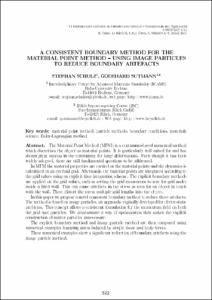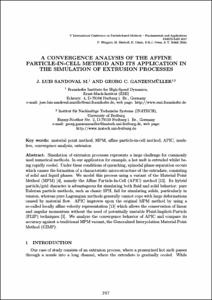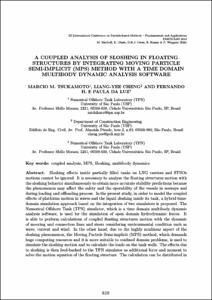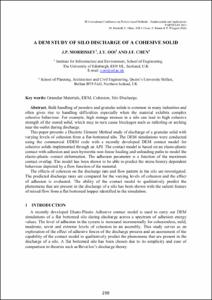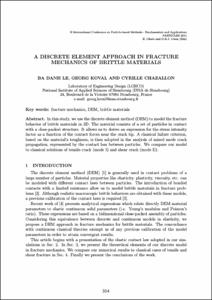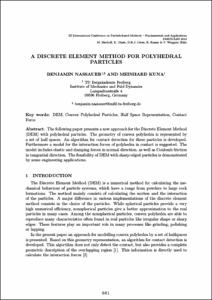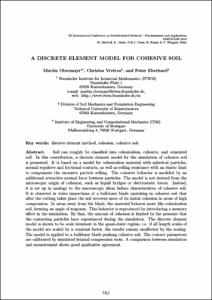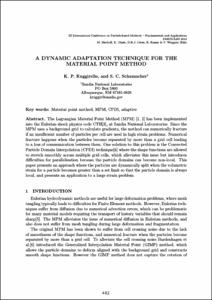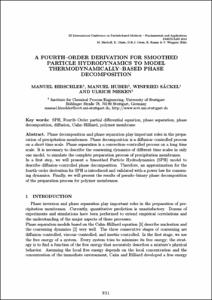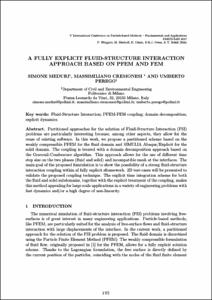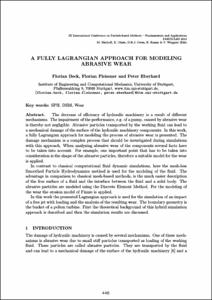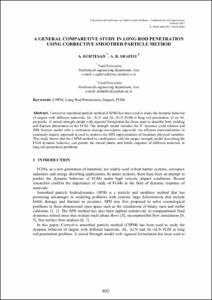Exploració per tema "Computational methods in mechanics"
Ara es mostren els items 1-20 de 443
-
3D laser scanning technique coupled with DEM GPU simulations for railway ballasts

(CIMNE, 2017)
(CIMNE, 2017)
Text en actes de congrés
Accés obertSpheres with complex contact models or clumped sphere models are classically used to model ballast for railway applications with the Discrete Element Method (DEM). These simplifications omits the angularity of the actual ... -
3D modelling of material flow in friction stir welding using movable cellular automaton method

(CIMNE, 2017)
(CIMNE, 2017)
Text en actes de congrés
Accés obertThe paper is devoted to the theoretical investigation of the peculiarities of material flow taking place in friction stir welding (FSW). The investigation was based on 3D computer simulation by the movable cellular automaton ... -
3D virtual laboratory for geotechnical applications: another perspective

(CIMNE, 2011)
(CIMNE, 2011)
Text en actes de congrés
Accés obertDiscrete element methods are important tools for investigating the mechanics of granular materials. In two dimensions, the reliability of these numerical approaches is increasingly being challenged, because they cannot ... -
A 3D generalized rigid particle contact model for rock fracture

(CIMNE, 2011)
(CIMNE, 2011)
Text en actes de congrés
Accés obertDetailed rigid particle models have been proposed for modeling fracture in quasibrittle materials. The rigid particle circular models proposed in the literature do not properly reproduce the known rock friction angle and ... -
A consistent boundary method for the material point method - using imge particles to reduce boundary artefacts

(CIMNE, 2019)
(CIMNE, 2019)
Text en actes de congrés
Accés obertThe material point method (MPM) is a continuum-based numerical method hich discretises the object as material points. It is particulary ell suited for and has shon great success in the community for large deformations. ... -
A convergence analysis of the affine particle-in-cell method and its application in the simulation of extrusion processes

(CIMNE, 2017)
(CIMNE, 2017)
Text en actes de congrés
Accés obertSimulation of extrusion processes represents a large challenge for commonly used numerical methods. In our application for example, a hot melt is extruded whilst being rapidly cooled. Under these conditions of quenching, ... -
A coupled analysis of sloshing in floating structures by integrating moving particle semi-implicit (MPS) method with a time domain multibody dynamic analysis software

(CIMNE, 2013)
(CIMNE, 2013)
Text en actes de congrés
Accés obertSloshing effects inside partially filled tanks on LNG carriers and FPSOs motions cannot be ignored. It is necessary to analyze the floating structures motion with the sloshing behavior simultaneously to obtain more accurate ... -
A DEM study of silo discharge of a cohesive solid

(CIMNE, 2013)
(CIMNE, 2013)
Text en actes de congrés
Accés obertBulk handling of powders and granular solids is common in many industries and often gives rise to handling difficulties especially when the material exhibits complex cohesive behaviour. For example, high storage stresses ... -
A discrete approach to describe the elastic-plastic behaviour of snow

(CIMNE, 2015)
(CIMNE, 2015)
Text en actes de congrés
Accés obertSnow is composed of small ice particles and, therefore, behaves as a granular material with a variety of sizes and shapes. Understanding the mechanical behaviour of snow is important in areas such as natural hazards e.g. ... -
A discrete element analysis of cohesive granular bulk solid materials

(CIMNE, 2015)
(CIMNE, 2015)
Text en actes de congrés
Accés obertIn bulk handling applications, such as conveying and storage, understanding the effect cohesion has upon the flow-ability of particulate systems at the macroscopic scale is crucial in increasing the avenues of operation ... -
A discrete element approach in fracture mechanics of brittle materials

(CIMNE, 2011)
(CIMNE, 2011)
Text en actes de congrés
Accés obertIn this study, we use the discrete element method (DEM) to model the fracture behavior of brittle materials in 2D. The material consists of a set of particles in contact with a close-packed structure. It allows us to derive ... -
A discrete element method for polyhedral particles

(CIMNE, 2013)
(CIMNE, 2013)
Text en actes de congrés
Accés obertThe following paper presents a new approach for the Discrete Element Method (DEM) with polyhedral particles. The geometry of convex polyhedra is represented by a set of half spaces. An algorithm for contact detection for ... -
A discrete element model for cohesive soil

(CIMNE, 2013)
(CIMNE, 2013)
Text en actes de congrés
Accés obertSoil can roughly be classified into cohesionless, cohesive, and cemented soil. In this contribution, a discrete element model for the simulation of cohesive soil is presented. It is based on a model for cohesionless material ... -
A domain-specific programming language for particle simulations on distributed-memory parallel computers

(CIMNE, 2013)
(CIMNE, 2013)
Text en actes de congrés
Accés obertWe present PPML, a domain-specific programming language for parallel particle and particle-mesh simulations. PPML provides a concise set of high-level abstractions for particle methods that significantly reduce implementation ... -
A dynamic adaptation technique for the material point method

(CIMNE, 2013)
(CIMNE, 2013)
Text en actes de congrés
Accés obertThe Lagrangian Material Point Method (MPM) [1, 2] has been implemented into the Eulerian shock physics code CTH[3], at Sandia National Laboratories. Since the MPM uses a background grid to calculate gradients, the method ... -
A fourth–order derivation for smoothed particle hydrodynamics to model thermodynamically–based phase decomposition

(CIMNE, 2013)
(CIMNE, 2013)
Text en actes de congrés
Accés obertPhase decomposition and phase separation play important roles in the preparation of precipitation membranes. Phase decomposition is a diffusion–controlled process on a short time scale. Phase separation is a convection–controlled ... -
A fully coupled 3D transport model in SPH for multi-species reaction-diffusion systems

(CIMNE, 2011)
(CIMNE, 2011)
Text en actes de congrés
Accés obertIn this paper we present a fully generalized transport model for multiple species in complex two and three-dimensional geometries. Based on previous work [1] we have extended our interfacial reaction-diffusion model to ... -
A fully explicit fluid-structure interaction approach based on PFEM and FEM

(CIMNE, 2017)
(CIMNE, 2017)
Text en actes de congrés
Accés obertPartitioned approaches for the solution of Fluid-Structure Interaction (FSI) problems are particularly interesting because, among other aspects, they allow for the reuse of existing software. In this work, we propose a ... -
A fully lagrangian approach for modeling abrasive wear

(CIMNE, 2013)
(CIMNE, 2013)
Text en actes de congrés
Accés obertThe decrease of efficiency of hydraulic machinery is a result of different mechanisms. The impairment of the performance, e.g. of a pump, caused by abrasive wear is thereby not negligible. Abrasive particles transported by ... -
A general comparetive study in long rod penetration using corrective smoothed particle method

(CIMNE, 2011)
(CIMNE, 2011)
Text en actes de congrés
Accés obertCorrective smoothed particle method (CSPM) has been used to study the dynamic behavior of targets with different materials; AL, ALN and AL-ALN FGM in long rod penetration of an AL projectile. A mixed strength model with ...






